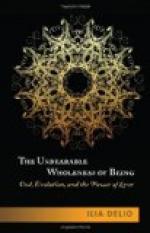A shining exception among the German nuns of that time was Mechthild of Magdeburg, a woman of rare gifts. She was a genuine mystic, but she, too, revelled in fervent, sensuous metaphors, and it would be an interesting task to separate the two elements in her case; but, having admitted her genuine mysticism in a previous chapter, I will here restrict myself to a few quotations which show her from her other side. Her Dialogue between Love and the Soul abounds in passages like the following: “Tell my beloved that his chamber is prepared, and that I am sick with love of him.” “The closer the embrace, the sweeter the kisses.” “Then He took the soul into His divine arms, and placing His fatherly hand on her bosom, He gazed into her face and kissed her right well.” Mechthild, too, was ready to die with love.
Everyone of the most celebrated Brides of Christ belonged to the Latin race; they were hysterics, and as such have long been claimed by the psychopathist.
The love of Jesus professed by Catherine of Siena (1347-1388), a clever politician, who was in correspondence with the leading statesmen of her time, found vent in passages like the following:
“I desire, then, that you withdraw into the open side of the Son of God, who is a bottle so full of perfume that even the things which are sinful become fragrant. There the bride reclines on a bed of fire and blood. There the secret of the heart of the Son of God is revealed and made manifest. Oh! Thou overflowing cup, refreshing and intoxicating every loving and yearning heart.” “I long to behold the body of my Lord!” And straightway the bridegroom appeared to her, opened his side and said to her: “Now drink as much of my blood as thou desirest.”
But the saint who enjoyed the greatest fame—partly on account of her frequent portrayal by the plastic arts—was doubtless St. Teresa (Teresia de Jesus), a Spanish nun (1515-1582). During childhood and early youth she suffered from serious illnesses, and on one occasion was even believed to be dead. “Before I felt the presence of God,” she says in her biography, “I experienced for some time a very delightful sensation, a sensation which I believe one is partly able to produce at will (!), a pleasure which is neither quite sensuous, nor quite spiritual, but which comes from God.” She describes in her “Life” four stages of prayer, which gradually lead the soul to God: “There is no joy to be compared with the joy which the Lord giveth to the soul in its exile. So great is this delight that frequently it seems that the least thing would make it forsake the body for ever.” “When the soul seeks God in this way,” the saint feels with supreme delight her strength ebbing away and a trance stealing over her until, devoid of breath and all physical strength she can only move her hand with great pain. The delights experienced by her are described in great detail and very sensuous language; hysterical conditions, such as painful convulsions, and hallucinations, are represented as religious phenomena. “It is dreadful what one has to suffer from confessors who do not understand these things,” she says in one of her writings with deep regret.




